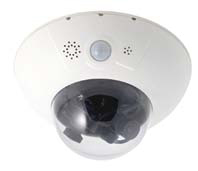How To Cover 1.4 Million Square Feet With Video Surveillance
By Mike Monocello, Business Solutions magazine
An integrator shares the details behind his 145-camera install for an upscale shopping mall.
Rob Merchant, president of MTS Intelligent Surveillance Solutions, recently completed an install for an upscale shopping mall in New Jersey. While you might not have customers that need to keep watch over a million plus square feet of space as Merchant had with this customer, the potential lessons learned by examining such installs make the story well worth reading.
 After being featured in a newspaper article on another surveillance project that involved him, Merchant was approached by the mall. According to the integrator, “The mall was looking to create a new IP video surveillance solution to provide high percentage coverage and 100% coverage on critical areas.” He goes on to explain that other design objectives included a state of the art command console area, remote access to video, the ability for police to remotely access the video, the ability for digital zoom for forensic review, license plate recognition for parking lot egress points, and the ability to incorporate intelligent features as they become feasible and desirable (e.g. face capture or face recognition).
After being featured in a newspaper article on another surveillance project that involved him, Merchant was approached by the mall. According to the integrator, “The mall was looking to create a new IP video surveillance solution to provide high percentage coverage and 100% coverage on critical areas.” He goes on to explain that other design objectives included a state of the art command console area, remote access to video, the ability for police to remotely access the video, the ability for digital zoom for forensic review, license plate recognition for parking lot egress points, and the ability to incorporate intelligent features as they become feasible and desirable (e.g. face capture or face recognition).
Additionally, the mall had a current analog CCTV DVRbased system in place. “It was agreed that this investment had some value and would be integrated into the overall solution,” he says. “Other design requirements included the ability to grow in number of cameras, camera locations, storage, and capability.”
MTS evaluated three alternatives regarding the network on which everything would reside: centralized home runs; distributed servers; and an MDF-IDF architecture, which became the design chosen. “We created a network infrastructure dedicated to the digital video system that had distributed Intermediate Data Frames [IDF] with Gigabit TCP/IP networking throughout,” he says. “Each IDF had fiber optic runs back to a centralized Main Data Frame [MDF] and had copper runs to the cameras. It was the quickest to implement, the most cost efficient, the most manageable, and the most flexible for growth.”
MTS designed the entire system and laid out three simultaneous and dependent projects, as well as a fourth project, new cameras. Project one was building the network infrastructure for the new IP-based system. Project two was building the head-end. Project three was the discovery, stabilization, and re-termination of the existing analog system. Once projects one and two were mostly complete, project four, the installation of new megapixel IP cameras, could begin.
Existing NTSC cameras were re-homed and encoded by both internal encoder cards in selected servers and Axis H.264 blade servers. New outdoor NTSC cameras were encoded at the closest IDF with external H.264 encoders. The remaining cameras are IP, configured as both VGA and megapixel HD cameras depending on placement, located throughout the facility. As wiring was a major cost, MTS relied heavily on dual sensor Mobotix IP cameras. In many cases, one Mobotix dome camera with two lenses essentially did the work of two cameras, thus drastically reducing the wiring and licensing costs.
Beyond the cameras, the solution included VMS Servers. MTS used HP Z800 servers (dual quad core Xeons) with TVISS16RT encoder boards for the analog cameras and four DL160 for the IP cameras. Each server has 4 TB of mirrored storage for the video.
MTS also designed and installed a 100% Gigabit Layer 2 Managed network with fiber optic links between IDFs to the MDF and Gigabit copper extensions from IDF to IDF extensions. Cisco Layer 3 managed switches support four class C subnetworks.
A Pivot3 RAIGE storage subsystem was configured as a network-attached storage array and is used for secondary storage. The NAS is configured as a RAID 6e platform, with 96 TB of storage, fully managed through an SNMP platform at MTS. On a typical day, over 2 TB of video are written to disk.
Remote access is achieved through a dedicated Apache Tomcat webserver with an ISS webview module that provides full functionality through web browser access.
Finally, MTS designed and built a command center for 24/7 operations that includes multiple large screen displays, an interactive map that allows users to choose camera views based on a map model of the mall, and a dedicated system for the production of optical disk evidence.
In the end, the mall was able to get the surveillance coverage it needed and provide law enforcement with usable video to help capture criminals. In the near future, MTS will be evaluating the people-counting feature built into the Mobotix cameras to provide the mall with additional functionality beyond loss prevention.
